
Thomas Rogers Kimball was an American architect in Omaha, Nebraska. An architect-in-chief of the Trans-Mississippi Exposition in Omaha in 1898, he served as national President of the American Institute of Architects from 1918 to 1920 and from 1919 to 1932 served on the Nebraska State Capitol Commission.

Holy Family Church was built in 1883 at 1715 Izard Street, at the intersections of 18th and Izard Streets in North Omaha, Nebraska within the Roman Catholic Archdiocese of Omaha. It is the oldest existing Catholic Church in Omaha, and is listed on the National Register of Historic Places.

The Bemis Park Landmark Heritage District is located in North Omaha, Nebraska. Situated from Cuming Street to Hawthorne Avenue, Glenwood Avenue to 33rd Street, Bemis Park was annexed into Omaha in 1887, and developed from 1889 to 1922. The district was designated an Omaha Landmark in 1983.
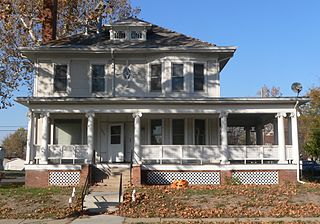
The George H. Kelly House is located at 1924 Binney Street in the Near North Side neighborhood of Omaha, Nebraska, United States. Built in 1904 in the Neo-Classical Revival style, it was listed on the National Register of Historic Places in 1983, and designated a City of Omaha architectural landmark that same year.

Calvin Memorial Presbyterian Church, located at 3105 North 24th Street, was formed in 1954 as an integrated congregation in North Omaha, Nebraska. Originally called the North Presbyterian Church, the City of Omaha has reported, "Calvin Memorial Presbyterian Church is architecturally significant to Omaha as a fine example of the Neo-Classical Revival Style of architecture." It was designated a City of Omaha landmark in 1985; it was listed on the National Register of Historic Places as North Presbyterian Church in 1986.
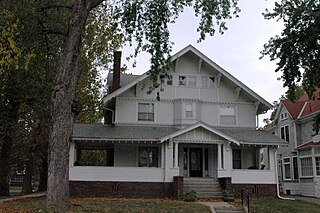
The Charles Storz House is located at 1901 Wirt Street in the Kountze Place neighborhood of North Omaha, Nebraska. The Arts and Crafts style house was designed by the Omaha architectural firm of Fisher and Lawrie and built in 1909. In 1983 it was renovated as a historic preservation project involving the National Trust for Historic Preservation, Landmarks, Inc., the City of Omaha and the Consumer Services Organization. In 1984 it was designated an Omaha Landmark.
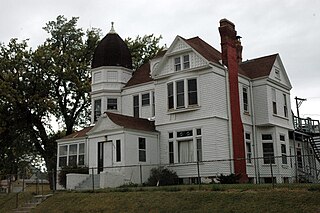
The John P. Bay House is located at 2024 Binney Street in the Kountze Place neighborhood of North Omaha, Nebraska. Built in 1887 by George L. Fisher, the house was designed in the Queen Anne style. It was designated an Omaha Landmark by the City of Omaha in 1981.

The Livestock Exchange Building in Omaha, Nebraska, was built in 1926 at 4920 South 30 Street in South Omaha. It was designed as the centerpiece of the Union Stockyards by architect George Prinz and built by Peter Kiewit and Sons in the Romanesque revival and Northern Italian Renaissance Revival styles. In 1999 it was designated an Omaha Landmark and listed on the National Register of Historic Places. The Union Stockyards were closed in 1999, and the Livestock Exchange Building underwent an extensive renovation over the next several years.

Vinton School was built as a fourteen-room elementary school in 1908 at 2120 Deer Park Boulevard in the Deer Park neighborhood of Omaha, Nebraska, United States. Designed by Omaha architect Frederick W. Clarke, Vinton School is the earliest and most elaborate example of a Tudor Revival-style school in Omaha. Designated an Omaha Landmark in June 1990, the building was listed on the National Register of Historic Places in November 1989.
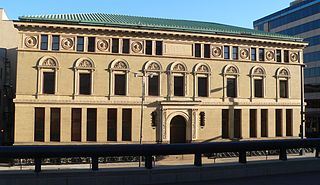
The original Omaha Public Library building was built in 1891 at 1823 Harney Street in downtown Omaha, Nebraska by renowned architect Thomas Kimball. Designed in the Second Renaissance Revival style, the building was designated an Omaha Landmark in October 1978, and was listed on the National Register of Historic Places that same year.

Mason School is located at 1012 South 24th Street in south Omaha, Nebraska, United States. Designed in the Richardson Romanesque style by the architectural firm of Mendelssohn, Fisher and Lawrie, the school was built in 1888 by the brick manufacturing and construction firm of Hadden, Rocheford & Gould. The school closed in the late 1970s and was converted into apartments. It was designated an Omaha Landmark in 1986 and listed on the National Register of Historic Places that same year.

The Nash Block, also known as the McKesson-Robbins Warehouse and currently as The Greenhouse, is located at 902-912 Farnam Street in Omaha, Nebraska. Designed by Thomas R. Kimball and built in 1907, the building is the last remnant of Downtown Omaha's Jobbers Canyon. It was named an Omaha Landmark in 1978, and was listed on the National Register of Historic Places in 1985.

The Edgar Zabriskie Residence is located at 3524 Hawthorne Avenue in the Bemis Park neighborhood of Omaha, Nebraska, United States. It was built in 1889 as one of the first homes in Bemis Park. The house was listed on the National Register of Historic Places in 1978 and was designated an Omaha Landmark in 1980.

Packer's National Bank Building is located at 4939 South 24th Street in the South Omaha Main Street Historic District in south Omaha, Nebraska. It was built in 1907. In 1984, it was designated an Omaha Landmark and, in 1985, it was listed on the National Register of Historic Places.

The Wattles House is located at 320 South 37th Street in the Midtown area of Omaha, Nebraska. Designed by renowned Omaha architect Thomas Rogers Kimball in the Chateauesque style, the house was built in 1895. It was designated an Omaha Landmark on April 11, 1995, and is part of the Gold Coast Historic District, which was listed as on the National Register of Historic Places.

The Rosewater School, now known as the Rosewater Apartments, is located in South Omaha, Nebraska, United States. Built in 1910, the building was named an Omaha Landmark on September 18, 1984, and added to the National Register of Historic Places in 1985.
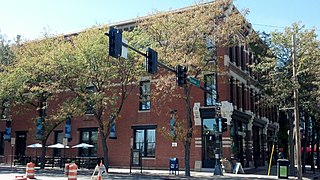
The Poppleton Block is located at 1001 Farnam Street in Downtown Omaha, Nebraska. The building was built in 1880 for Omaha lawyer and politician A.J. Poppleton, and was designated an Omaha Landmark on July 13, 1982, and was listed on the National Register of Historic Places later that year.
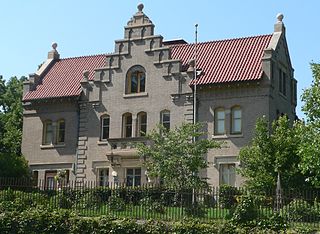
The Mary Rogers Kimball House, also known as the Kimball House, is located at 2236 St. Mary's Avenue in Downtown Omaha, Nebraska.
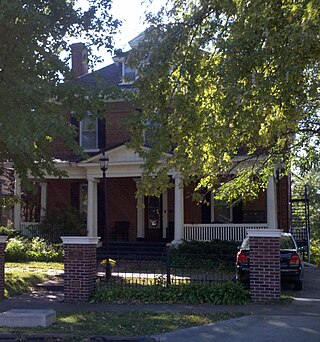
The Breckenridge–Gordon House is located at 3611 Jackson Street in Midtown Omaha, Nebraska. Built in 1905, the house was designed by Thomas Rogers Kimball for a prominent local attorney. Designated as an Omaha Landmark in 1982, the residence is located in the Gold Coast Historic District, which is listed on the National Register of Historic Places.




















